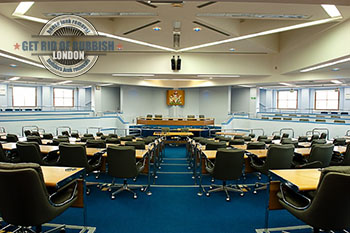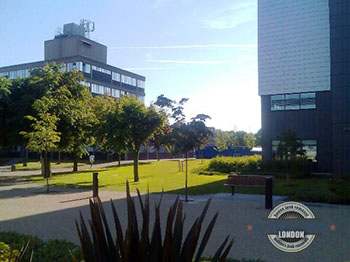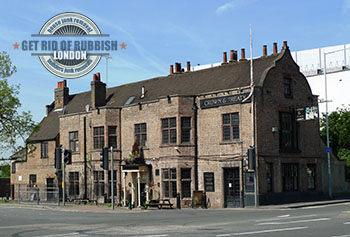Hillingdon is one of the thirty two administrative divisions of the British capital. The borough occupies the western frontier of Greater London and has a population of about two hundred seventy five thousand people. By size, Hillingdon is the second largest of all London boroughs. For administrative reasons, the borough is split into North and South Hillingdon. The governing body of the district is Hillingdon Council, with its headquarters located in the Civic Centre of Uxbridge. Like many of London’s other boroughs, Hillingdon is the result of a merger of a number of former districts, these were Hayes and Harlington, Yiewsley and West Drayton, Uxbridge and Ruislip-Northwood. At the time of its formation, the new borough still had no name. The governing council had somewhat hard time in settling and agreeing on a name. One of the first suggestions was to name it Uxbridge, but this was not accepted by other forming parties, so the name Hillingdon was chosen and applied instead. Shortly after its official establishment in nineteen sixty five, Hillingdon also got its own coat of arms. The governing centre of Hillingdon took shape in Uxbridge during the late nineteen seventies.
 Originally, the southern half of Hillingdon had strong associations and presence of industry, in the years after nineteen eighty this has diminished with the district being redeveloped mainly for residential purposes. The northern half of the borough has been residential since its forming. The borough’s suburban layout expanded greatly during the early nineteen hundreds, when the Metropolitan Railway’s extension began servicing the district. Hillingdon is a prime example of London’s so called ‘Metroland’ – the forming of residential suburbs by the Metropolitan Railway Company. Since two thousand eleven, plans and proposals have been put in effect to create more public transport services in the borough, namely the Central Line to be extended further out to Hillingdon.
Originally, the southern half of Hillingdon had strong associations and presence of industry, in the years after nineteen eighty this has diminished with the district being redeveloped mainly for residential purposes. The northern half of the borough has been residential since its forming. The borough’s suburban layout expanded greatly during the early nineteen hundreds, when the Metropolitan Railway’s extension began servicing the district. Hillingdon is a prime example of London’s so called ‘Metroland’ – the forming of residential suburbs by the Metropolitan Railway Company. Since two thousand eleven, plans and proposals have been put in effect to create more public transport services in the borough, namely the Central Line to be extended further out to Hillingdon.
During the second half of the twentieth century, Hillingdon has shaped to be a good place to live for many people, this has been repeatedly indicated by surveys and opinion polls conducted amongst local residents and London residents as a whole. The borough is one of the greenest and least densely populated districts of the capital, a far cry from the Eastern suburbs. At the moment, Hillingdon borough administration is looking after and maintaining over two hundred public parks and green open spaces, totalling to seven hundred and thirty hectares of land. At the same time, a notable portion of Hillingdon is part of London’s Metropolitan Greenbelt. The local administration had vowed to protect and preserve the Greenbelt – as per governing body – no one or nothing will be touching or changing the Greenbelt on their watch. Unfortunately though, the promise was not kept and in twenty twelve, those same people informed local residents of plans to build on some of the oldest and most loved commons in the borough. Despite public discontent, the plans were stamped for go-ahead. Besides parks and green open spaces, Hillingdon is also home to a number of lidos and canals, and of course the portion of the Grand Union Canal which passes through it.
 In terms of local economy, Hillingdon’s is well developed and prosperous. By national rankings, the borough’s economy is the fourteenth strongest out of four hundred and eight local economise to have been entered in the survey. By local standards, Hillingdon has the fifth strongest economy of all thirty two London boroughs. The presence of Great Britain’s largest and busiest international airport – Heathrow, in Hillingdon has always been a major boost for the local economy. Heathrow Airport has attracted the European headquarters of many major airlines to Hillingdon, the importance of supporting and additional industries to the airport is also an important aspect of the local economic stability. A number of international corporations (non-aviation related) have also chosen Hillingdon borough for their European and main headquarters.
In terms of local economy, Hillingdon’s is well developed and prosperous. By national rankings, the borough’s economy is the fourteenth strongest out of four hundred and eight local economise to have been entered in the survey. By local standards, Hillingdon has the fifth strongest economy of all thirty two London boroughs. The presence of Great Britain’s largest and busiest international airport – Heathrow, in Hillingdon has always been a major boost for the local economy. Heathrow Airport has attracted the European headquarters of many major airlines to Hillingdon, the importance of supporting and additional industries to the airport is also an important aspect of the local economic stability. A number of international corporations (non-aviation related) have also chosen Hillingdon borough for their European and main headquarters.
A number of important government departments are also situated within Hillingdon, they are UK’s Visas and Immigration Department, the Colnbrook Immigration Removal Centre and Harmondsworth Immigration Removal Centre.
Hillingdon has also got plenty to offer when it comes to education, culture and recreation facilities. A number of child and family recreation centres are owned and managed by Hillingdon council, ensuring public access for everyone. Hillingdon council also maintains a total of seventeen public libraries, situated across the borough. In twenty eleven, Hillingdon Borough Council was awarded the Library Innovation of The Year Award, and the Booksellers Industry Award for the same year. Brunel University (one of London’s main tertiary institutions) is located in Hillingdon, so is Uxbridge College. Hillingdon Council operates and looks after four well known theatres, all within the borough. They are The Open Air Theatre in Barra Hall Park, Hayes, The Winston Churchill Theatre and Hall – which is also part of the Manor Farm estate, The Beck Theatre in Hayes, and the Compass Theatre in Ickenham.
 The Borough of Hillingdon is made up of seventeen suburbs or areas. Some of them are Cowley – a suburban village featuring 16 Grade Listed Buildings, Ickenham – an old suburban village dating back to Roman times, South Ruislip – an important memorial site for Polish fighter pilots of WWII, Ruislip – a village designated as cultural heritage, Yiewsley – a settlement dating back to the Anglo-Saxon period, Harlington – a ninth century village, now occupying the northern perimeter of Heathrow Airport, Northwood – an elevated residential suburb, featured in different TV shows and movies, West Drayton – home to a large conservation area as well as a number of grade listed structures, Hayes – a settlement of ancient origins, also home to a number of grade listed buildings, Eastcote – an old village associated with certain events in British history.
The Borough of Hillingdon is made up of seventeen suburbs or areas. Some of them are Cowley – a suburban village featuring 16 Grade Listed Buildings, Ickenham – an old suburban village dating back to Roman times, South Ruislip – an important memorial site for Polish fighter pilots of WWII, Ruislip – a village designated as cultural heritage, Yiewsley – a settlement dating back to the Anglo-Saxon period, Harlington – a ninth century village, now occupying the northern perimeter of Heathrow Airport, Northwood – an elevated residential suburb, featured in different TV shows and movies, West Drayton – home to a large conservation area as well as a number of grade listed structures, Hayes – a settlement of ancient origins, also home to a number of grade listed buildings, Eastcote – an old village associated with certain events in British history.
The borough of Hillingdon is well connected to other parts of the city through a large number of bus lines, operated by various transport companies. There are also quite a few National Rail and London Underground lines running to and from Hillingdon. This is in part in order to ensure sufficient transit of passengers to and from Heathrow Airport, which isn’t always the case though as Londoners know all too well.
